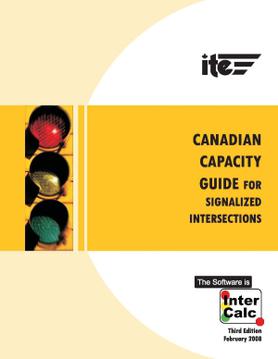
Transportation engineering or transport engineering is the application of technology and scientific principles to the planning, functional design, operation and management of facilities for any mode of transportation in order to provide for the safe, efficient, rapid, comfortable, convenient, economical, and environmentally compatible movement of people and goods transport.

Traffic engineering is a branch of civil engineering that uses engineering techniques to achieve the safe and efficient movement of people and goods on roadways. It focuses mainly on research for safe and efficient traffic flow, such as road geometry, sidewalks and crosswalks, cycling infrastructure, traffic signs, road surface markings and traffic lights. Traffic engineering deals with the functional part of transportation system, except the infrastructures provided.

Traffic congestion is a condition in transport that is characterized by slower speeds, longer trip times, and increased vehicular queueing. Traffic congestion on urban road networks has increased substantially since the 1950s. When traffic demand is great enough that the interaction between vehicles slows the traffic stream, this results in congestion. While congestion is a possibility for any mode of transportation, this article will focus on automobile congestion on public roads.

Parking is the act of stopping and disengaging a vehicle and usually leaving it unoccupied. Parking on one or both sides of a road is often permitted, though sometimes with restrictions. Some buildings have parking facilities for use of the buildings' users. Countries and local governments have rules for design and use of parking spaces.
In economics, induced demand – related to latent demand and generated demand – is the phenomenon whereby an increase in supply results in a decline in price and an increase in consumption. In other words, as a good or service becomes more readily available and mass produced, its price goes down and consumers are more likely to buy it, meaning that the quantity demanded subsequently increases. This is consistent with the economic model of supply and demand.

The American Society of Civil Engineers (ASCE) is a tax-exempt professional body founded in 1852 to represent members of the civil engineering profession worldwide. Headquartered in Reston, Virginia, it is the oldest national engineering society in the United States. Its constitution was based on the older Boston Society of Civil Engineers from 1848.

The car-free movement is a broad, informal, emergent network of individuals and organizations, including social activists, urban planners, transportation engineers, environmentalists and others, brought together by a shared belief that large and/or high-speed motorized vehicles are too dominant in most modern cities. The goal of the movement is to create places where motorized vehicle use is greatly reduced or eliminated, by converting road and parking space to other public uses and rebuilding compact urban environments where most destinations are within easy reach by other means, including walking, cycling, public transport, personal transporters, and mobility as a service.

The street hierarchy is an urban planning technique for laying out road networks that exclude automobile through-traffic from developed areas. It is conceived as a hierarchy of roads that embeds the link importance of each road type in the network topology. Street hierarchy restricts or eliminates direct connections between certain types of links, for example residential streets and arterial roads, and allows connections between similar order streets or between street types that are separated by one level in the hierarchy. By contrast, in many regular, traditional grid plans, as laid out, higher order roads are connected by through streets of both lower order levels. An ordering of roads and their classification can include several levels and finer distinctions as, for example, major and minor arterials or collectors.

Complete streets is a transportation policy and design approach that requires streets to be planned, designed, operated and maintained to enable safe, convenient and comfortable travel and access for users of all ages and abilities regardless of their mode of transportation. Complete Streets allow for safe travel by those walking, cycling, driving automobiles, riding public transportation, or delivering goods.
A professional transportation planner is a professional engaged in the practice of transportation planning, relating to the transportation aspects of urban planning and infrastructure planning.

The Louisiana Department of Transportation and Development (DOTD) is a state government organization in the United States, in charge of maintaining public transportation, roadways, bridges, canals, select levees, floodplain management, port facilities, commercial vehicles, and aviation which includes 69 airports, in the U.S. state of Louisiana. The agency has approximately five thousand personnel on staff and an operating budget of $2.3 billion. DOTD operations are run through nine district offices across the state.

Wrong-way driving (WWD), also known as contraflow driving, is the act of driving a motor vehicle against the direction of traffic. It can occur on either one- or two-way roads, as well as in parking lots and parking garages, and may be due to driver inattention or impairment, or because of insufficient or confusing road markings or signage, or a driver from a right-hand traffic country being unaccustomed to driving in a left-hand traffic country, and vice versa. People intentionally drive in the wrong direction because they missed an exit, for thrill-seeking, or as a shortcut.

Portland Orange is the color of light emitted by the dont walk phase of pedestrian crossing signals in the United States and Canada. The color was chosen to avoid confusion with regular traffic lights in conditions of poor visibility.

Donald Curran Shoup is an American engineer and professor in urban planning. He is a research professor of urban planning at University of California, Los Angeles and a noted Georgist economist. His 2005 book The High Cost of Free Parking identifies the negative repercussions of off-street parking requirements and relies heavily on 'Georgist' insights about optimal land use and rent distribution. In 2015, the American Planning Association awarded Shoup the "National Planning Excellence Award for a Planning Pioneer."

The Canadian Capacity Guide for Signalized Intersections (CCG) is a publication of the Canadian Institute of Transportation Engineers (CITE). It provides a methodology that allows Traffic Engineers to plan, design, and evaluate traffic signal controlled roadway intersections.
The Canadian Institute of Transportation Engineers (CITE) is composed of more than 1,700 transportation engineers, planners, technologists and students across Canada. Its purpose and mission is to enable professionals with knowledge and competence in transportation and traffic engineering to contribute individually and collectively towards meeting needs for mobility and safety within Canada.
Ernest Payson Goodrich was an American pioneer in urban planning and engineering, the first president of the Institute of Transportation Engineers, and the third head coach of the Michigan State Normal School football team.

The High Cost of Free Parking is an urban planning book by UCLA professor Donald Shoup dealing with the costs of free parking on society. It is structured as a criticism of the planning and regulation of parking and recommends that parking be built and allocated according to its fair market value. It incorporates elements of Shoup's Georgist philosophy.

Parking mandates or parking requirements are policy decisions, usually taken by municipal governments, which require new developments to provide a particular number of parking spaces.
The 85th percentile speed or 85th percentile rule is a traffic engineering standard used to set the speed limit for automobiles on a public roadway. It refers to a speed where 85% of vehicles travel at or below.















